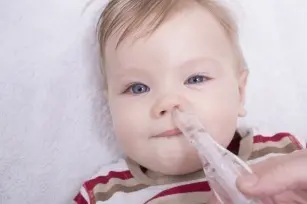
There can be many reasons for a stuffy nose – most often it means an infection or a cold, but it can also be a symptom of an allergy. It is very troublesome for both children and adults, interfering with everyday activities, sleeping, as well as worsening the taste of food and contributing to a weaker appetite. The symptoms of a stuffy nose can be cured with home remedies, but remember not to ignore it, because the residual secretion is a breeding ground for bacteria. They can cause worse health complications over time, such as pharyngitis or bronchitis.
A stuffy nose and runny nose can signal many ailments, such as infections, allergies, or birth defects. Among the obstacles causing nasal congestion that are associated with congenital abnormalities are craniopharynx malformations, tumors, choanal stenosis, and cysts of the nasal cavity. Symptoms of a stuffy nose include:
- night apnea,
- Snore,
- discharge in the nose,
- mouth breathing,
- Headache,
- The presence of discharge in the nose,
- Dyspnoea,
- Irritability and bad mood
- Difficulty falling asleep, sleepiness during the day
- Sinica,
- food problem,
- Problem with pronouncing nasal sounds.
The symptoms of obstruction are most pronounced and distressing in newborns because they cannot breathe through their mouths.
How to cure a stuffy nose in children?
- Using a bulb/aspirator – they allow you to clean your nose mechanically. You can find a pear or an aspirator in every pharmacy. We use them several times a day, especially before feeding and going to bed. The nosepiece must be cleaned after each use. It is important to be careful not to pull too hard when using the aspirator, as doing so too forcefully can irritate your baby’s mucous membranes. In older children, secretions can be suctioned more strongly.
- Essential oils – choose oils of plant origin, which are also available in pharmacies, e.g. pine or eucalyptus oil (avoid menthol and camphor!). They have analgesic, warming, antibacterial and facilitate breathing. Remember to mix them with hot water, thanks to which you will receive an infusion ready for inhalation. Another way is to rub the preparation on the chest or use oil-soaked patches to stick it on.
- Drainage (tapping) – another method is patting, i.e. placing the child on his stomach so that his head is lower than the rest of the body, and then patting the child’s chest area (on both sides), above the lungs. The hand should be bent into a boat (there should be a hollow inside the hand, thanks to which the blows will be cushioned). Do not perform such a massage over the spine and kidneys. This procedure is painless and will help to remove the discharge. It’s best not to do it on the bare back, but in a thin body, for example.









